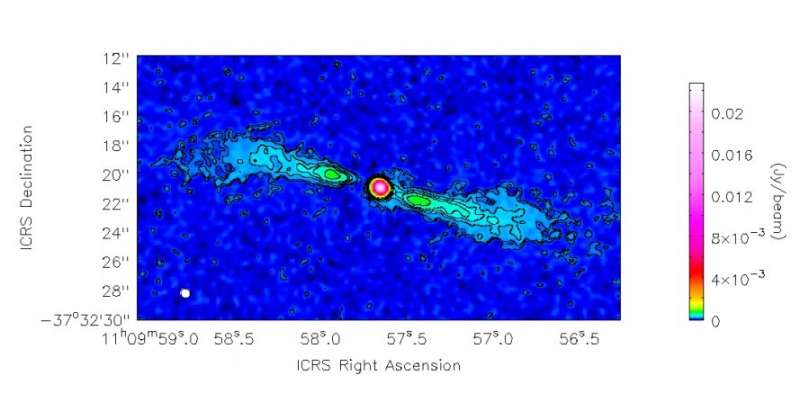Continuum ALMA image of the inner 36'' of NGC 3557 at 3mm. Credit: Vila-Vilaró et al., 2018.
Using Atacama Large Millimeter/submillimeter Array (ALMA), researchers have conducted interferometric observations of the elliptical galaxy NGC 3557 to investigate molecular gas emission from this source. Results of these observations, available in a paper published December 13 on arXiv.org, could be helpful for understanding the process of star formation in this galaxy.
Although many surveys of molecular gas emission from galaxies have been performed to date, only few studies have been carried out on the physical conditions of molecular gas, especially carbon monoxide (CO), in elliptical galaxies. This could be due to the overall weakness of the molecular emission in such galaxies and small apparent size of these structures.
The currently small number of such studies and high demand for that kind of observations motivated a group of astronomers led by Baltasar Vila-Vilaró of the ALMA Observatory in Chile to investigate the galaxy NGC 3557. Located some 130 million light years away from the Earth, NGC 3557 is a southern-sky elliptical galaxy and a member of a small group of galaxies. It was classified as a flat-spectrum radio galaxy with a jet that bends at distances of a few arcmin from the center.
Vila-Vilaró's team chose NGC 3557 due to its relative proximity and CO-brightness, which facilitates the study of its molecular structures in detail. Moreover, NGC 3557 is assumed to be in a stage where little current star formation may be happening, hence astronomers perceive it as an important representative of the molecular gas structures to be expected in post-star formation scenarios.
"As part of the ALMA program 2015.1.00591.S (P.I.: Baltasar Vila-Vilaró), we observed the southern elliptical galaxy NGC 3557 in the 12CO(1–0) line (ALMA Band 3)," the researchers wrote in the paper.
According to the study, the astronomers detected the CO(1-0) emission line, and a relatively strong continuum at 3mm exhibiting flat-spectrum central unresolved source and two jets associated with the larger scale emission observed at lower frequencies. They added that the molecular gas appears to be concentrated within the inner 815 light years of the galaxy, near the location of the unresolved flat-spectrum source.
The authors of the paper found that the total integrated CO(1-0) flux is 4.5 Jy km/s, which indicates a molecular hydrogen mass of about 90 million solar masses or a total molecular gas mass including helium of approximately 122 million solar masses. They noted that these values differ quite significantly from those reported in similar previous study of NGC 3557 conducted in 2010.
Furthermore, the average value of the integrated intensity line ratio CO(2-1)/CO(1-0) was found to be 0.7. This value in NGC 3557 is relatively high when compared with values reported in other elliptical galaxies observed with single-dish telescopes and could be related to the interaction of the molecular gas with the radio jet plasma.
The researchers have also investigated the kinematics of the molecular gas in NGC 3557 and found that it has some organized rotation with the same orientation as the nuclear dust absorption detected with the Hubble Space Telescope (HST).
More information: P. Vila-Vilaro et al. ALMA Observations of the Molecular Gas in the Elliptical Galaxy NGC3557. arXiv:1812.05385 [astro-ph.GA] arxiv.org/abs/1812.05385
© 2018 Science X Network
























